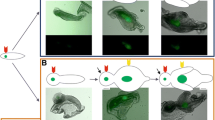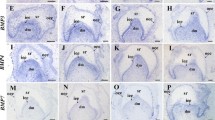Abstract
Developmental process of rat maxillary incisor has been studied through histological analysis and investigation of tooth-related gene expression patterns at initial tooth development. The tooth-related genes studied here are fibroblast growth factor-8 (Fgf-8), pituitary homeobox gene-2 (Pitx-2), sonic hedgehog (Shh), muscle segment homeobox-1 (Msx-1), paired box-9 (Pax-9) and bone morphogenetic protein-4 (Bmp-4). The genes are expressed in oral epithelium and/or ectomesenchyme at the stage of epithelial thickening to the early bud stage of tooth development. Both the histological observation and tooth-related gene expression patterns during early stage of maxillary incisor development demonstrate that dual odontogenic origins aligned medio-laterally in the medial nasal process develop, subsequently only single functional maxillary incisor dental placode forms. The cascade of tooth-related gene expression patterns in rat maxillary incisor studied here is quite similar to those of the previous studies in mouse mandibular molar, even though the origins of oral epithelium and ectomesenchyme involved in development of maxillary incisor and mandibular molar are different. Thus, we conclude that maxillary incisor and mandibular molar share a similar signaling control of Fgf-8, Pitx-2, Shh, Msx-1, Pax-9 and Bmp-4 genes at the stage of oral epithelial thickening to the early bud stage of tooth development.






Similar content being viewed by others
References
Bei M, Maas R (1998) FGFs and BMP4 induce both Msx1-independent and Msx1-dependent signaling pathways in early tooth development. Development 125:4325–4323
Couly GF, Le Douarin NM (1985) Mapping of the early neural primordium in quail-chick chimeras. I. Developmental relationships between placodes, facial ectoderm, and prosencephalon. Dev Biol 110:422–439
Couly GF, Le Douarin NM (1987) Mapping of the early neural primordium in quail-chick chimeras. II. The prosencephalic neural plate and neural folds: implications for the genesis of cephalic human congenital abnormalities. Dev Biol 120:198–214
Hardcastle Z, Mo R, Hui CC, Sharpe PT (1998) The Shh signalling pathway in tooth development: defects in Gli2 and Gli3 mutants. Development 125:2803–2811
Jernvall J, Kettunen P, Karavanova I, Martin LB, Thesleff I (1994) Evidence for the role of the enamel knot as a control center in mammalian tooth cusp formation: non-dividing cells express growth stimulating Fgf-4 gene. Int J Dev Biol 38:463–469
Keranen SV, Kettunen P, Aberg T, Thesleff I, Jernvall J (1999) Gene expression patterns associated with suppression of odontogenesis in mouse and vole diastema regions. Dev Genes Evol 209:495–506
Kettunen P, Thesleff I (1998) Expression and function of FGFs-4, -8, and -9 suggest functional redundancy and repetitive use as epithelial signals during tooth morphogenesis. Dev Dyn 211:256–268
Lumsden AG (1988) Spatial organization of the epithelium and the role of neural crest cells in the initiation of the mammalian tooth germ. Development 103 (Suppl):155–169
Matsuo T, Osumi-Yamashita N, Noji S, Ohuchi H, Koyama E, Myokai F, Matsuo N, Taniguchi S, Doi H, Iseki S et al (1993) A mutation in the Pax-6 gene in rat small eye is associated with impaired migration of midbrain crest cells. Nat Genet 3:299–304
Mina M, Kollar EJ (1987) The induction of odontogenesis in non-dental mesenchyme combined with early murine mandibular arch epithelium. Arch Oral Biol 32:123–127
Mucchielli ML, Mitsiadis TA, Raffo S, Brunet JF, Proust JP, Goridis C (1997) Mouse Otlx2/RIEG expression in the odontogenic epithelium precedes tooth initiation and requires mesenchyme-derived signals for its maintenance. Dev Biol 189:275–284
Osumi-Yamashita N, Ninomiya Y, Doi H, Eto K (1994) The contribution of both forebrain and midbrain crest cells to the mesenchyme in the frontonasal mass of mouse embryos. Dev Biol 164:409–419
Peterkova R, Peterka M, Viriot L, Lesot H (2000) Dentition development and budding morphogenesis. J Craniofac Genet Dev Biol 20:158–172
Peterkova R, Peterka M, Vonesch JL, Ruch JV (1993) Multiple developmental origin of the upper incisor in mouse: histological and computer assisted 3-D-reconstruction studies. Int J Dev Biol 37:581–588
Peterkova R, Peterka M, Vonesch JL, Ruch JV (1995) Contribution of 3-D computer-assisted reconstructions to the study of the initial steps of mouse odontogenesis. Int J Dev Biol 39:239–247
Peters H, Neubuser A, Kratochwil K, Balling R (1998) Pax9-deficient mice lack pharyngeal pouch derivatives and teeth and exhibit craniofacial and limb abnormalities. Genes Dev 12:2735–2747
Satokata I, Maas R (1994) Msx1 deficient mice exhibit cleft palate and abnormalities of craniofacial and tooth development. Nat Genet 6:348–356
Serbedzija GN, Bronner-Fraser M, Fraser SE (1992) Vital dye analysis of cranial neural crest cell migration in the mouse embryo. Development 116:297–307
St Amand TR, Zhang Y, Semina EV, Zhao X, Hu Y, Nguyen L, Murray JC, Chen Y (2000) Antagonistic signals between BMP4 and FGF8 define the expression of Pitx1 and Pitx2 in mouse tooth-forming anlage. Dev Biol 217:323–332
Strassburg M, Peter S, Eitel H (1970) Zur Morphogenese der Zahnleiste. II Histologische Untersuchungen über die frühesten Differenzierungsphasen der Zahnleiste bei der Maus. Dtsch Zahnärztl Z 26:52–57
Tan SS, Morriss-Kay GM (1986) Analysis of cranial neural crest cell migration and early fates in postimplantation rat chimaeras. J Embryol Exp Morphol 98:21–58
Thesleff I, Vaahtokari A, Vainio S, Jowett A (1996) Molecular mechanisms of cell and tissue interactions during early tooth development. Anat Rec 245:151–161
Tucker AS, Matthews KL, Sharpe PT (1998) Transformation of tooth type induced by inhibition of BMP signaling. Science 282:1136–1138
Vaahtokari A, Aberg T, Jernvall J, Keranen S, Thesleff I (1996) The enamel knot as a signaling center in the developing mouse tooth. Mech Dev 54:39–43
Vainio S, Karavanova I, Jowett A, Thesleff I (1993) Identification of BMP-4 as a signal mediating secondary induction between epithelial and mesenchymal tissues during early tooth development. Cell 75:45–58
Acknowledgements
This research was supported by the Thailand Research Fund, JSPS-NRCT Core University Program and Grants-in-Aid for Scientific Research from MEXT Japan.
Author information
Authors and Affiliations
Corresponding author
Rights and permissions
About this article
Cite this article
Kriangkrai, R., Iseki, S., Eto, K. et al. Dual odontogenic origins develop at the early stage of rat maxillary incisor development. Anat Embryol 211, 101–108 (2006). https://doi.org/10.1007/s00429-005-0068-7
Accepted:
Published:
Issue Date:
DOI: https://doi.org/10.1007/s00429-005-0068-7




